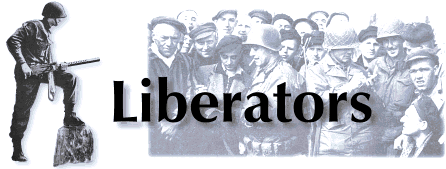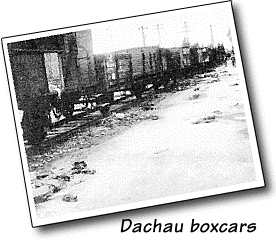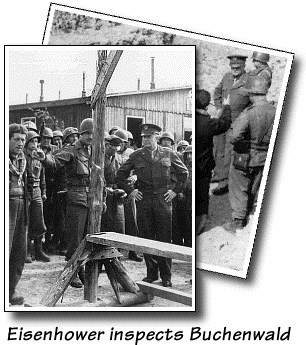
Allied troops, physicians, and relief workers tried to provide nourishment and medicine for the prisoners, but many were too weak and could not be saved.
Liberators' stories...
 There were about a
dozen bodies in the dirty boxcar, men and women alike. They had gone
without food for so long that their dead wrists were broomsticks tipped
with claws....
There were about a
dozen bodies in the dirty boxcar, men and women alike. They had gone
without food for so long that their dead wrists were broomsticks tipped
with claws....
Someone broke the silence with a curse and then with a roar the men started for the camp on the double...the men were plain fighting mad. They went down that road without any regard for cover or concealment. No one was afraid, not after those boxcars.
--British officer Peter Coombs, in a letter to his wife
 I saw Eisenhower go to the opposite end of the road and vomit. From a
distance I saw Patton
bend over, holding his head with one hand and his abdomen with the other.
And I soon became
ill. I suggested to General Eisenhower that cables be sent immediately to
President Roosevelt,
Churchill, DeGaulle, urging people to come and see for themselves. The
general nodded.
I saw Eisenhower go to the opposite end of the road and vomit. From a
distance I saw Patton
bend over, holding his head with one hand and his abdomen with the other.
And I soon became
ill. I suggested to General Eisenhower that cables be sent immediately to
President Roosevelt,
Churchill, DeGaulle, urging people to come and see for themselves. The
general nodded.
--Lewis H. Weinstein, Lieutenant Colonel and chief of the liaison section of General Eisenhower's staff, April 1945
I have never felt able to describe my emotional reaction when I first came
face to face with
indisputable evidence of Nazi brutality and ruthless disregard of every
shred of decency...I visited
every nook and cranny of the camp because I felt it my duty to be in a
position from then on to
testify at first hand about these things in case there ever grew up at
home the belief or assumption
that the stories of Nazi brutality were just propaganda.
--General Dwight D. Eisenhower, Supreme Commander, Allied Forces, Europe, Letter to Chief of Staff George Marshall, April 12, 1945
 As we entered the
camp, the living skeletons still able to walk crowded around us and, though
we
wanted to drive farther into the place, the milling, pressing crowd would not
let us. It is not an
exaggeration to say that almost every inmate was insane with hunger. Just
the sight of an
American brought cheers, groans and shrieks. People crowded around to
touch an American, to
touch the jeep, to kiss our arms--perhaps just to make sure that it was
true. The people who
couldn't walk crawled out toward our jeep. Those who couldn't even crawl
propped themselves
up on an elbow, and somehow, through all their pain and suffering,
revealed through their eyes
the gratitude, the joy they felt at the arrival of Americans.
As we entered the
camp, the living skeletons still able to walk crowded around us and, though
we
wanted to drive farther into the place, the milling, pressing crowd would not
let us. It is not an
exaggeration to say that almost every inmate was insane with hunger. Just
the sight of an
American brought cheers, groans and shrieks. People crowded around to
touch an American, to
touch the jeep, to kiss our arms--perhaps just to make sure that it was
true. The people who
couldn't walk crawled out toward our jeep. Those who couldn't even crawl
propped themselves
up on an elbow, and somehow, through all their pain and suffering,
revealed through their eyes
the gratitude, the joy they felt at the arrival of Americans.
--Captain J.D. Pletcher, 71st Division Headquarters
Visit the Resource section to view photographs of Allied troops advancing into German territory and the liberation of the camps.
Visit the Resource section to view photographs of the camps immediately after liberation and inspection tours by General Eisenhower.
This site offers
Chuck Ferree's account of the liberation of Dachau concentration camp.
This personal and
in-depth account of the liberation of Buchenwald by Harry J. Herder, Jr.
offers great detail in its descriptions.
Staff Sgt. Albert J. Kosiek describes the liberation of Mauthausen and Gusen camps.
Colonel Edmund M. of the
United States Army, describes Mauthausen shortly after its liberation. (Photo,
video, audio, and text)
This is a brief
description of Abram Sachar's experience in the liberation of Dachau.
Retired Brigadier General Felix Sparks
recalls the liberation of Dachau in a speech made at the United States
Holocaust Memorial Museum.
General Sparks offers his perspective on the
liberation of Dachau.
First hand
observations of Dachau and Buchenwald concentration camps are shared. This
site also has information about displaced persons camps.
Interactive quiz on liberators.
Lesson plans, discussion questions, term paper topics, reproducible handouts, and other resources for teaching about liberators are available here.
Produced by the Florida Center for Instructional Technology,
College of Education, University of South Florida © 1997-2013.